
The Ohio class of nuclear-powered submarines includes the United States Navy's 14 ballistic missile submarines (SSBNs) and its four cruise missile submarines (SSGNs). Each displacing 18,750 tons submerged, the Ohio-class boats are the largest submarines ever built for the U.S. Navy. They are also the third-largest submarines ever built, behind the Russian Navy's Soviet era 48,000-ton Typhoon class, the last of which was retired in 2023, and 24,000-ton Borei class. Capable of carrying 24 Trident II missiles apiece, the Ohio class are equipped with just as many missiles as, if not more than, either the Borei class (16) or the deactivated Typhoon class (20).
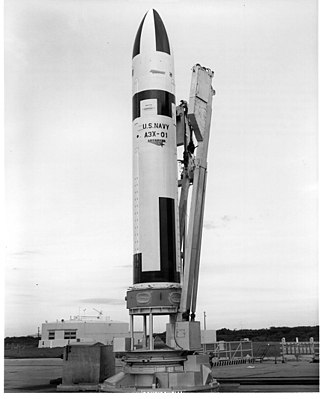
The UGM-27 Polaris missile was a two-stage solid-fueled nuclear-armed submarine-launched ballistic missile (SLBM). As the United States Navy's first SLBM, it served from 1961 to 1980.
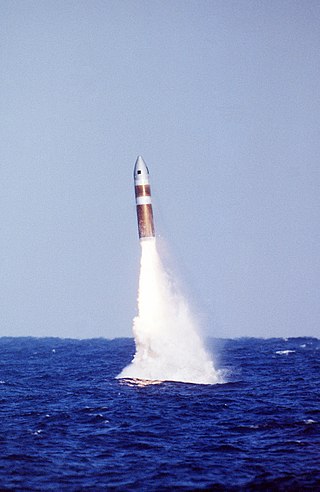
The UGM-73 Poseidon missile was the second US Navy nuclear-armed submarine-launched ballistic missile (SLBM) system, powered by a two-stage solid-fuel rocket. It succeeded the UGM-27 Polaris beginning in 1972, bringing major advances in warheads and accuracy. It was followed by Trident I in 1979, and Trident II in 1990.

The Trident missile is a submarine-launched ballistic missile (SLBM) equipped with multiple independently targetable reentry vehicles (MIRV). Originally developed by Lockheed Missiles and Space Corporation, the missile is armed with thermonuclear warheads and is launched from nuclear-powered ballistic missile submarines (SSBNs). Trident missiles are carried by twelve United States Navy Ohio-class submarines, with American warheads, as well as four Royal Navy Vanguard-class submarines, with British warheads. The missile is named after the mythological trident of Neptune.

A submarine-launched ballistic missile (SLBM) is a ballistic missile capable of being launched from submarines. Modern variants usually deliver multiple independently targetable reentry vehicles (MIRVs), each of which carries a nuclear warhead and allows a single launched missile to strike several targets. Submarine-launched ballistic missiles operate in a different way from submarine-launched cruise missiles.
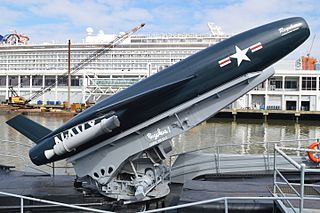
The SSM-N-8A Regulus or the Regulus I was a United States Navy-developed ship-and-submarine-launched, nuclear-capable turbojet-powered second generation cruise missile, deployed from 1955 to 1964. Its development was an outgrowth of U.S. Navy tests conducted with the German V-1 missile at Naval Air Station Point Mugu in California. Its barrel-shaped fuselage resembled that of numerous fighter aircraft designs of the era, but without a cockpit. Test articles of the Regulus were equipped with landing gear and could take off and land like an airplane. When the missiles were deployed they were launched from a rail launcher, and equipped with a pair of Aerojet JATO bottles on the aft end of the fuselage.
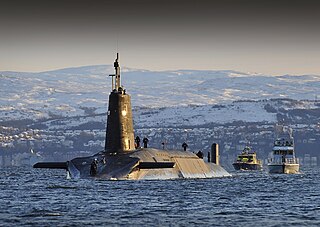
The Vanguard class is a class of nuclear-powered ballistic missile submarines (SSBNs) in service with the Royal Navy. The class was introduced in 1994 as part of the Trident nuclear programme, and comprises four vessels: Vanguard, Victorious, Vigilant and Vengeance, built between 1986 and 1999 at Barrow-in-Furness by Vickers Shipbuilding and Engineering, now owned by BAE Systems. All four boats are based at HM Naval Base Clyde , 40 km (25 mi) west of Glasgow, Scotland.

Chevaline was a system to improve the penetrability of the warheads used by the British Polaris nuclear weapons system. Devised as an answer to the improved Soviet anti-ballistic missile defences around Moscow, the system increased the probability that at least one warhead would penetrate Moscow's anti-ballistic missile (ABM) defences, something which the Royal Navy's earlier UGM-27 Polaris re-entry vehicles (RVs) were thought to be unlikely to do.
A ballistic missile submarine is a submarine capable of deploying submarine-launched ballistic missiles (SLBMs) with nuclear warheads. These submarines became a major weapon system in the Cold War because of their nuclear deterrence capability. They can fire missiles thousands of kilometers from their targets, and acoustic quieting makes them difficult to detect, thus making them a survivable deterrent in the event of a first strike and a key element of the mutual assured destruction policy of nuclear deterrence. The deployment of ballistic missile submarines is dominated by the United States and Russia. Smaller numbers are in service with France, the United Kingdom, China and India; North Korea is also suspected to have an experimental submarine that is diesel-electric powered.

The Lafayette class of submarine was an evolutionary development from the Ethan Allen class of fleet ballistic missile submarine, slightly larger and generally improved. This class, together with the George Washington, Ethan Allen, James Madison, and Benjamin Franklin classes, composed the "41 for Freedom," the Navy's primary contribution to the nuclear deterrent force through the late 1980s. The James Madison and Benjamin Franklin classes are combined with the Lafayettes in some references.
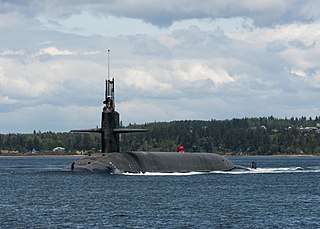
USS Alabama (SSBN-731) is the sixth Ohio-class nuclear-powered ballistic missile submarine, and the seventh United States vessel to be named for the state of Alabama. The boat's motto duplicates the state's motto, Audemus Jura Nostra Defendere.

The UGM-133A Trident II, or Trident D5 is a submarine-launched ballistic missile (SLBM), built by Lockheed Martin Space in Sunnyvale, California, and deployed with the United States and Royal Navy. It was first deployed in March 1990, and remains in service. The Trident II Strategic Weapons System is an improved SLBM with greater accuracy, payload, and range than the earlier Trident C-4. It is a key element of the U.S. strategic nuclear triad and strengthens U.S. strategic deterrence. The Trident II is considered to be a durable sea-based system capable of engaging many targets. It has payload flexibility that can accommodate various treaty requirements, such as New START. The Trident II's increased payload allows nuclear deterrence to be accomplished with fewer submarines, and its high accuracy—approaching that of land-based missiles—enables it to be used as a first strike weapon.

USS Casimir Pulaski (SSBN-633), a James Madison-class ballistic missile submarine, was the second ship of the United States Navy to be named for Casimir Pulaski (1745–1779), a Polish general who served in the American Revolutionary War.

USS Von Steuben (SSBN-632), a James Madison-class fleet ballistic missile submarine, was the second ship of the United States Navy to be named for Baron Friedrich Wilhelm von Steuben (1730–1794), a Prussian army officer who served in the American Revolutionary War.

A drag-reducing aerospike is a device used to reduce the forebody pressure aerodynamic drag of blunt bodies at supersonic speeds. The aerospike creates a detached shock ahead of the body. Between the shock and the forebody a zone of recirculating flow occurs which acts like a more streamlined forebody profile, reducing the drag.
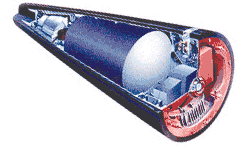
The W76 is an American thermonuclear warhead, designed for use on the UGM-96 Trident I submarine-launched ballistic missiles (SLBMs) and subsequently moved to the UGM-133 Trident II as Trident I was phased out of service. The first variant, the W76 mod 0 (W76-0) was manufactured from 1978 to 1987, and was gradually replaced by the W76 mod 1 (W76-1) between 2008 and 2018, completely replacing the Mod 0 in the active stockpile. In 2018 it was announced that some Mod 1 warheads would be converted to a new low-yield W76 mod 2 (W76-2) version. The first Mod 2 warheads were deployed in late 2019.

Trident, also known as the Trident nuclear programme or Trident nuclear deterrent, covers the development, procurement and operation of nuclear weapons in the United Kingdom and their means of delivery. Its purpose as stated by the Ministry of Defence is to "deter the most extreme threats to our national security and way of life, which cannot be done by other means". Trident is an operational system of four Vanguard-class submarines armed with Trident II D-5 ballistic missiles, able to deliver thermonuclear warheads from multiple independently targetable re-entry vehicles (MIRVs). It is operated by the Royal Navy and based at Clyde Naval Base on the west coast of Scotland. At least one submarine is always on patrol to provide a continuous at-sea capability. The missiles are manufactured in the United States, while the warheads are British.
The UGM-89 Perseus was a proposed U.S. Navy submarine-launched anti-ship (AShM) and anti-submarine (ASW) cruise missile that was developed under the Submarine Tactical Missile (STAM) project, which was also referred to as the Submarine Anti-ship Weapon System (STAWS). This missile system was to be the centerpiece for a proposed third-generation nuclear-powered cruise missile submarine championed by then-Vice Admiral Hyman G. Rickover, the influential but controversial head of the Navy's nuclear propulsion program.

The Harpoon is an all-weather, over-the-horizon, anti-ship missile manufactured by McDonnell Douglas. The AGM-84E Standoff Land Attack Missile (SLAM) and later AGM-84H/K SLAM-ER are cruise missile variants.
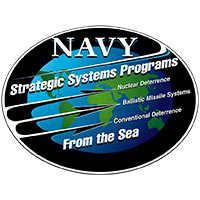
A Demonstration and Shakedown Operation (DASO) is a series of missile tests conducted by the United States Navy and the Royal Navy. These tests are employed to validate a weapon system (SLBM) and ensure a submarine crew's readiness to use that system. A shakedown operation usually occurs after a refueling and overhaul process or construction of a new submarine. Testing of missile systems allows collection of flight-data, and examinations of submarine launch platforms.


















